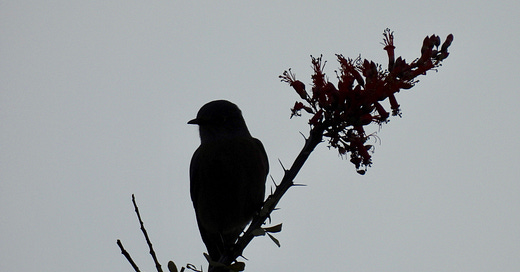Identify the Image Description, Round 2!
How well do you know these summer birds?
Dear Friends,
The birds don't sing when it rains. Like humans, they hunker down, clinging to their loved ones as they wait for the storms to pass. Even the rain crow is still, and silent. But sometimes, there is no escape from the rushing water. Sometimes all we can do is surrender to the flow, and pray for salvation. Or, we watch from afar, shocked that a place of such beauty can wreak such devastation and suffering.
In the wake of last week's floods, I, too, beg for meaning. What purpose can there be in the deaths of children? In the destruction of Hill Country communities, which will take years to rebuild? I have no answers, only grief and compassion. And a hope that we will honor those we have lost by striving for something better, by growing into the selves we long to become.
May we hold our children a little tighter. May we love a little harder. May we reach beyond ourselves and give freely to those we do not know. May we form a closer and healthier bond with the natural world, even as we weep for the pain it has wrought. And, perhaps, this terrible tragedy will have some meaning after all.
A Note about Image Descriptions
Earlier this year I wrote about the importance of describing images for people who are blind or visually impaired. (Check out my previous post to learn more about image descriptions and alt-text.)
In providing this accommodation for my readers, I have amassed quite a collection of image descriptions! It occurred to me after a year or so that these descriptions might also serve as a teaching tool for sighted birders to test their identification skills.
So, for those who could use the distraction, I offer the following activity. Try to identify the bird species detailed in each description below. I included the location and season where you might find each bird as extra clues!
Remember: this is just for fun. Even if you don't know the answers, you are still a birder! Even if you don't care to identify birds, you are still a birder! To be a birder, all you need to do is enjoy birds, in whatever manner you please.
I will share the answers in my next post. (Or you can email me as well.) Until then!
Enjoy the birds,
Eric
Quiz: Identify the Bird in Each Image Description
High Island, Texas in April: A bright pink wading bird flies with outstretched wings across a clear blue sky. A long white neck contrasts with the bird’s otherwise pinkish plumage. As conspicuous as the bird’s coloration is its long and unusual spatula-shaped bill. Pink legs and a red eye complete the look of this unique coastal bird.
Tucson, Arizona in July: A dazzling orange-red songbird perches on a branch with its head turned to the side. The bird has a crest of slightly raised flame-like feathers at the back of its head, and a dark brown stripe that cuts across the center of its face to enclose a gleaming black eye. Rough hairs bristle about the base of the bird’s medium-length black bill while dark brown wings supply a neat outline to the bird’s otherwise fiery plumage.
Austin, Texas in May: A small songbird peers out from the entrance hole of a sandy brown gourd-shaped nest. The nest is made of a thousand or more pellets of mud and looks as though it was cemented to the overhang. The bird has a black eye and a very wide and short black bill that’s perfect for catching insects. Its throat is dark rusty orange, and navy-blue colors its crown. Particularly conspicuous is the bird’s off-white forehead.
Bolivar Peninsula, Texas in June: Four tall delicate-looking shorebirds stand at the grassy edge of a lustrous mud flat. They have white under parts and black stretching across the wings, back, nape, and crown. Their bills are dainty, black, and medium-long. Their legs are lanky and pink.
Austin, Texas in June: A small yellow and green songbird holds its head to the side while perched on a leafless twig. The bird has black legs, a blunt black bill, and a fairly short tail. Yellow spectacles enwrap the bird’s conspicuous white iris. Yellow also colors its flanks and enlivens its otherwise black and white wings and tail. A yellowish-green back and pale gray throat and nape round out the bird’s plumage.




